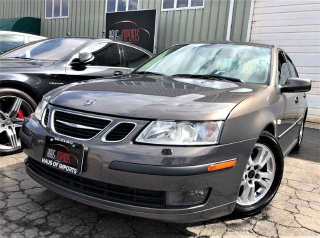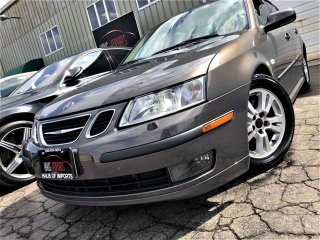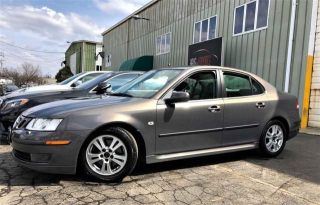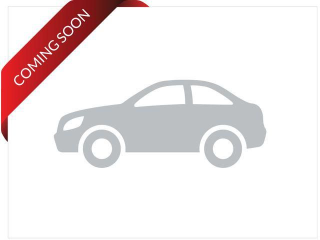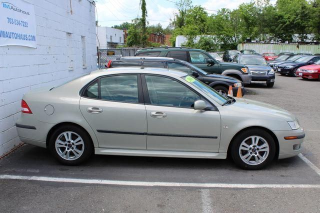The 2006 Saab 9-3 is a compact executive car that continued Saab's legacy of distinctive Swedish design and a focus on the driver's experience. Model years for this generation spanned from 2003 to 2011, with the 2006 model year offering sedan, sportcombi (hatchback), and convertible body styles. Key trims included the Linear, Vector, and the performance-oriented Aero. New pricing ranged from approximately $27,000 to $38,000. It stands out for its unique styling, turbocharged engine options, and a slightly quirky, yet comfortable interior, appealing to those seeking an alternative to more common German luxury brands.
The Good
The 2006 Saab 9-3 offers engaging turbocharged performance and a comfortable, refined ride. Its distinctive Scandinavian design appeals to emotional buyers, while practical aspects include good fuel economy and a solid build for its era, providing a strong value proposition.
The Bad
Potential buyers should watch out for common electrical gremlins, especially with the infotainment and climate control systems. Ignition coil failures are frequent, and some owners report issues with the turbocharger and transmission over time. Regular maintenance is crucial.
2006 Saab 9-3: Quick Overview
- Engine Options:
The 2006 Saab 9-3 offered two primary turbocharged four-cylinder engine options:- A 2.0-liter turbocharged engine available in various states of tune.
- A more powerful 2.8-liter turbocharged V6 engine, primarily found in the Aero trim.
- Horsepower:
- The standard 2.0T engine typically produced around 175-200 horsepower, depending on the specific tune and trim.
- The Aero trim's 2.8T V6 engine delivered significantly more power, often in the range of 250-255 horsepower.
- Fuel Economy:
Fuel economy varied based on the engine and transmission. For the 2.0T, expect combined MPG ratings in the low to mid-20s (e.g., around 21-23 MPG combined). The more powerful V6 would see slightly lower figures, perhaps in the high teens to low 20s combined. - 0-60 Times:
- Models equipped with the 2.0T engine generally accelerated from 0-60 mph in the 7-8 second range.
- The more potent Aero V6 could achieve 0-60 mph in approximately 6-7 seconds, offering a sportier feel.
- Towing Capacity:
The Saab 9-3 was not designed or marketed for towing. Therefore, towing capacity is generally considered not applicable or very limited, typically not exceeding a few hundred pounds for light trailers if equipped with a hitch (which is rare). - Trim-Level Features:
- Linear: This base trim offered a good starting point with features like air conditioning, power windows and locks, a CD player, cruise control, and comfortable cloth upholstery.
- Vector: Stepping up to the Vector trim added more premium touches, such as leather upholstery, larger alloy wheels, a sport-tuned suspension, upgraded interior trim, and often a more powerful audio system.
- Aero: The top-tier Aero model was performance-oriented, featuring the more powerful V6 engine, sport suspension, unique aerodynamic styling cues, premium leather sport seats, larger wheels, and often HID headlights.
2006 Saab 9-3 Specifications
Vehicle Information
| Year | 2006 |
| Make | Saab |
| Model | 9-3 |
| Trim | - |
| Style | Sedan 2.0-T |
| Type | Sedan |
| Category | Subcompact Car |
Manufacturing Details
| Made In | Sweden |
| Manufacturing City | GRAZ |
Dimensions
| Doors | 4-Door |
| Curb Weight | 3550 pounds |
| Gross Vehicle Weight Rating | 4340 pounds |
| Overall Height | 56.40 inches |
| Overall Length | 182.40 inches |
| Overall Width | 69.30 inches |
| Wheelbase Length | 105.30 inches |
| Standard Seating | 4 |
Engine & Performance
| Engine | 2.0-L I4 |
| Engine Size | 2L |
| Engine Cylinders | 4 |
| Transmission | 5-Speed Automatic |
| Transmission Type | Automatic |
| Transmission Speeds | 5-Speed |
| Drivetrain | Front-Wheel Drive |
Additional Features
| Anti-Brake System | 4-Wheel ABS |
| Steering Type | Rack & Pinion |
Pricing
| Manufacturer Suggested Retail Price (MSRP) | $36,500 |
| Invoice Price | $34,434 |
| Delivery Charges | $720 |
Vehicle History Report
Vehicle
Specifications
Specifications
Ownership
History
History
All History
Events
Events
NMVTIS Title
History Check
History Check
Salvage/Rebuilt
Check
Check
Accident
Check
Check
Theft
Check
Check
Open Lien
Check
Check
Past Sale
Listings
Listings
Safety
Recalls
Recalls
Odometer
Check
Check
Market Price
Analysis
Analysis
What Problems Does the 2006 Saab 9-3 Have?
The 2006 Saab 9-3, like many vehicles from its era, has a set of commonly reported issues that owners should be aware of. One of the most persistent problems revolves around the ignition system. Ignition coil failures are quite frequent, often leading to misfires and rough running. This is a relatively common and often straightforward repair, but it can be a nuisance.
Electrical issues are another significant area of concern. Owners have frequently reported problems with the central locking system, power windows, and the climate control module (often referred to as the "eSID" or electronic Saab Information Display). These issues can manifest as inoperative components or erratic behavior. Sometimes these are simple fixes like loose connections, but other times they can involve more complex module replacements.
The Direct Ignition (DI) cassette, which houses the spark plugs and ignition coils, is a known weak point. When one of these fails, the engine can run very poorly, and diagnostic trouble codes will often point to specific cylinder misfires.
Over time, the turbocharger system can also develop issues. Leaks in the intercooler hoses or the turbocharger itself can lead to a loss of boost, resulting in sluggish performance. Seals within the turbo can also wear out, necessitating a rebuild or replacement.
Transmission issues, particularly with the automatic transmission, have been reported. While not as widespread as ignition problems, some owners have experienced premature wear, leading to harsh shifting or complete failure. Regular fluid changes are essential to prolong the life of the automatic gearbox.
While specific widespread recalls for the 2006 model year that stand out are not as common as some other manufacturers, it's always wise to check the NHTSA website for any outstanding recalls that might apply to a specific VIN.
Long-term reliability can be good if the vehicle has been meticulously maintained. However, due to the unique nature of Saab parts and the declining dealership network, repairs can sometimes be more costly or harder to source than for more mainstream brands. Owners who are proactive with maintenance and address issues promptly tend to have a more positive ownership experience.
Electrical issues are another significant area of concern. Owners have frequently reported problems with the central locking system, power windows, and the climate control module (often referred to as the "eSID" or electronic Saab Information Display). These issues can manifest as inoperative components or erratic behavior. Sometimes these are simple fixes like loose connections, but other times they can involve more complex module replacements.
The Direct Ignition (DI) cassette, which houses the spark plugs and ignition coils, is a known weak point. When one of these fails, the engine can run very poorly, and diagnostic trouble codes will often point to specific cylinder misfires.
Over time, the turbocharger system can also develop issues. Leaks in the intercooler hoses or the turbocharger itself can lead to a loss of boost, resulting in sluggish performance. Seals within the turbo can also wear out, necessitating a rebuild or replacement.
Transmission issues, particularly with the automatic transmission, have been reported. While not as widespread as ignition problems, some owners have experienced premature wear, leading to harsh shifting or complete failure. Regular fluid changes are essential to prolong the life of the automatic gearbox.
While specific widespread recalls for the 2006 model year that stand out are not as common as some other manufacturers, it's always wise to check the NHTSA website for any outstanding recalls that might apply to a specific VIN.
Long-term reliability can be good if the vehicle has been meticulously maintained. However, due to the unique nature of Saab parts and the declining dealership network, repairs can sometimes be more costly or harder to source than for more mainstream brands. Owners who are proactive with maintenance and address issues promptly tend to have a more positive ownership experience.
How long will the 2006 Saab 9-3 last?
Based on owner data and anecdotal evidence, a well-maintained 2006 Saab 9-3 can reliably reach an average mileage of 150,000 to 200,000 miles, with many examples exceeding 250,000 miles. The inherent robustness of the turbocharged engines, particularly the B205 and B284 series, contributes to their longevity. However, long-term durability is heavily influenced by the owner's maintenance habits. Neglecting regular oil changes, ignoring early signs of ignition issues, or failing to service the transmission can significantly shorten its lifespan. Key weaknesses that emerge over time include the electrical system, particularly the SID unit and associated wiring, and potential turbocharger wear. Proactive maintenance, especially addressing ignition coil issues and ensuring cooling system integrity, is paramount for maximizing the 9-3's service life.
What Technology & Safety Features are Included?
The 2006 Saab 9-3 offered a blend of Scandinavian practicality and a focus on driver engagement, with its technology and safety features reflecting this ethos. Standard entertainment typically included an AM/FM stereo with a CD player. Higher trims and optional packages could upgrade this to a more sophisticated sound system, often from Harman Kardon, featuring more speakers and improved audio quality. Bluetooth connectivity was not standard in 2006 and would have been a rare aftermarket addition. The Saab Information Display (SID) was a signature feature, providing trip computer functions, fuel economy readouts, and system warnings, though as mentioned, this unit could be prone to failure over time.
Driver-assistance features were relatively basic by modern standards. Standard safety equipment included anti-lock brakes (ABS), electronic brakeforce distribution (EBD), traction control (TCS), and stability control (ESC). Multiple airbags were standard, typically including front airbags, side-impact airbags for the front occupants, and optional rear side airbags. For convertible models, pop-up rollover protection bars were a significant safety innovation.
Optional features could enhance the driving experience and comfort, such as heated leather seats, a power-adjustable driver's seat with memory, automatic climate control, and a sunroof. Xenon headlights were also available on higher trims or as part of option packages, improving nighttime visibility.
Crash-test ratings for the Saab 9-3 from this generation were generally favorable. The National Highway Traffic Safety Administration (NHTSA) awarded the 9-3 sedan and sportcombi top marks (five stars) in frontal and side-impact crash tests for both the driver and front passenger. The Insurance Institute for Highway Safety (IIHS) also rated the 2006 Saab 9-3 as a "Top Safety Pick" in many categories, highlighting its structural integrity and occupant protection in various impact scenarios. These strong safety ratings contributed to its appeal as a secure and well-built vehicle.
Driver-assistance features were relatively basic by modern standards. Standard safety equipment included anti-lock brakes (ABS), electronic brakeforce distribution (EBD), traction control (TCS), and stability control (ESC). Multiple airbags were standard, typically including front airbags, side-impact airbags for the front occupants, and optional rear side airbags. For convertible models, pop-up rollover protection bars were a significant safety innovation.
Optional features could enhance the driving experience and comfort, such as heated leather seats, a power-adjustable driver's seat with memory, automatic climate control, and a sunroof. Xenon headlights were also available on higher trims or as part of option packages, improving nighttime visibility.
Crash-test ratings for the Saab 9-3 from this generation were generally favorable. The National Highway Traffic Safety Administration (NHTSA) awarded the 9-3 sedan and sportcombi top marks (five stars) in frontal and side-impact crash tests for both the driver and front passenger. The Insurance Institute for Highway Safety (IIHS) also rated the 2006 Saab 9-3 as a "Top Safety Pick" in many categories, highlighting its structural integrity and occupant protection in various impact scenarios. These strong safety ratings contributed to its appeal as a secure and well-built vehicle.
What Colors Options are Available?
2006 Saab 9-3 Prices and Market Value
When new, the 2006 Saab 9-3 had a manufacturer's suggested retail price (MSRP) that typically ranged from around $27,000 for a base Linear sedan to upwards of $38,000 for a fully equipped Aero convertible. As with most vehicles, the 9-3 experienced significant depreciation in its early years. Currently, the used market price for a 2006 Saab 9-3 varies widely based on condition, mileage, trim level, and body style. You can often find examples for sale between $3,000 and $8,000, with exceptionally clean or low-mileage models potentially commanding slightly more. Factors affecting resale value include its distinctive styling which appeals to a niche market, its perceived reliability concerns compared to some German rivals, and the availability of specialized parts and service. Well-maintained examples with good service records tend to hold their value better.
2006 Saab 9-3 Cost of Ownership
Ownership costs for a 2006 Saab 9-3 are generally moderate, leaning towards slightly more costly than average for its class, particularly for repairs. Insurance premiums are typically competitive, falling in line with other compact executive sedans. Fuel costs are reasonable, with the 2.0T engine offering decent MPG. Maintenance is crucial; regular oil changes and attention to common issues like ignition coils can prevent more expensive problems. Repair costs can be higher than for mainstream brands due to the specialized nature of Saab parts and the diminishing number of dedicated service centers. Overall, while not prohibitively expensive, it requires diligent upkeep to remain economical.
2006 Saab 9-3 Fuel Efficiency
Fuel Type
Gasoline
Fuel Capacity
23 gallons
City Mileage
19 miles/gallon
Highway Mileage
29 miles/gallon
2006 Saab 9-3 Safety Rating
NHTSA
IIHS
2006 Saab 9-3 Warranty
Basic
Original warranty
48 months / 50,000 miles
Estimated remaining
Expired
Powertrain
Original warranty
48 months / 50,000 miles
Estimated remaining
Expired
Rust
Original warranty
120 months / unlimited miles
Estimated remaining
Expired
2006 Saab 9-3 Insurance
Insurance for a 2006 Saab 9-3 is moderately priced, reflecting its status as a Sedan with strong safety ratings and
reasonable repair costs.
reasonable repair costs.
How Does the 2006 Saab 9-3 Compare to Other Sedan?
The 2006 Saab 9-3 competed in the premium compact segment against rivals like the BMW 3 Series, Audi A4, Mercedes-Benz C-Class, and Acura TL.
Performance: In terms of performance, the Saab 9-3, especially in Aero trim with its V6 turbo, offered potent acceleration that could rival or even surpass some of its German competitors. The 2.0T models provided spirited driving dynamics with a comfortable ride, distinguishing it from the sometimes harsher setups of rivals.
Features: The 9-3 offered a unique interior design with a driver-focused cockpit and comfortable, supportive seats. While it had good standard safety features and optional premium audio, it generally lagged behind the cutting edge of technology and luxury appointments found in the BMW or Audi of the same year, particularly regarding advanced infotainment and driver aids.
Reliability: This is where the Saab 9-3 often falls short compared to its rivals. While German luxury brands have their own set of potential issues, brands like Acura generally boast superior long-term reliability and lower repair costs. The 9-3's common electrical problems and ignition issues can make it less dependable over time than a well-maintained Acura TL or even a Japanese competitor.
Price: The Saab 9-3 typically offered a better value proposition when new, often priced lower than comparable BMWs or Mercedes. Used, this trend continues, making it a more affordable entry into the premium segment.
Alternatives:
For similar performance and a more engaging driving experience with potentially better reliability, the BMW 3 Series (E90 generation) is a strong contender, though it will likely be more expensive to purchase and maintain.
If reliability and a comfortable, refined ride are paramount, the Acura TL is an excellent alternative, offering a powerful V6 engine and high-quality interior at a competitive price point, with significantly better long-term durability.
The Audi A4 offers sophisticated styling and handling, though it too can be costly to repair.
For a similar budget, a well-maintained Infiniti G35 can also be considered, offering strong performance and a sporty character.
Performance: In terms of performance, the Saab 9-3, especially in Aero trim with its V6 turbo, offered potent acceleration that could rival or even surpass some of its German competitors. The 2.0T models provided spirited driving dynamics with a comfortable ride, distinguishing it from the sometimes harsher setups of rivals.
Features: The 9-3 offered a unique interior design with a driver-focused cockpit and comfortable, supportive seats. While it had good standard safety features and optional premium audio, it generally lagged behind the cutting edge of technology and luxury appointments found in the BMW or Audi of the same year, particularly regarding advanced infotainment and driver aids.
Reliability: This is where the Saab 9-3 often falls short compared to its rivals. While German luxury brands have their own set of potential issues, brands like Acura generally boast superior long-term reliability and lower repair costs. The 9-3's common electrical problems and ignition issues can make it less dependable over time than a well-maintained Acura TL or even a Japanese competitor.
Price: The Saab 9-3 typically offered a better value proposition when new, often priced lower than comparable BMWs or Mercedes. Used, this trend continues, making it a more affordable entry into the premium segment.
Alternatives:
For similar performance and a more engaging driving experience with potentially better reliability, the BMW 3 Series (E90 generation) is a strong contender, though it will likely be more expensive to purchase and maintain.
If reliability and a comfortable, refined ride are paramount, the Acura TL is an excellent alternative, offering a powerful V6 engine and high-quality interior at a competitive price point, with significantly better long-term durability.
The Audi A4 offers sophisticated styling and handling, though it too can be costly to repair.
For a similar budget, a well-maintained Infiniti G35 can also be considered, offering strong performance and a sporty character.
Final Verdict: Is the 2006 Saab 9-3 a Good Sedan?
The 2006 Saab 9-3 is ideal for the discerning buyer who appreciates distinctive Scandinavian design, a comfortable and engaging driving experience, and wants to stand out from the typical luxury car crowd. It's a car for someone who values character over absolute cutting-edge technology or bulletproof, low-cost reliability.
Whether it's worth buying hinges heavily on its condition and price. As a used car, it offers a compelling value for its performance and premium feel, especially in Aero trim. However, potential buyers must be aware of its known weaknesses, particularly electrical issues and ignition system quirks. It's best suited for enthusiasts who are comfortable with potentially higher maintenance costs and the availability of specialized parts or have access to a knowledgeable independent mechanic. Buying one with a solid maintenance history and getting a pre-purchase inspection are non-negotiable steps. A new purchase is not an option, making this a strictly used-car recommendation.
Whether it's worth buying hinges heavily on its condition and price. As a used car, it offers a compelling value for its performance and premium feel, especially in Aero trim. However, potential buyers must be aware of its known weaknesses, particularly electrical issues and ignition system quirks. It's best suited for enthusiasts who are comfortable with potentially higher maintenance costs and the availability of specialized parts or have access to a knowledgeable independent mechanic. Buying one with a solid maintenance history and getting a pre-purchase inspection are non-negotiable steps. A new purchase is not an option, making this a strictly used-car recommendation.
